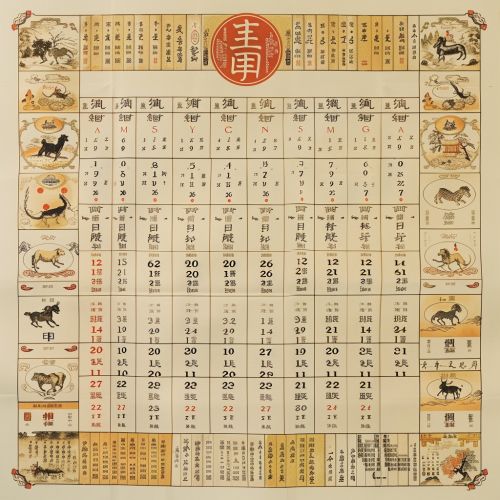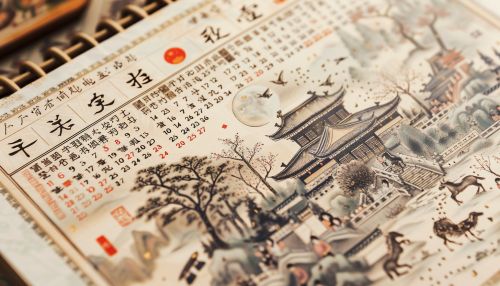Chinese calendar
Overview
The Chinese calendar is a lunisolar calendar that is used to reckon the traditional East Asian calendars. It is a complex system that incorporates both lunar and solar cycles, with the lunar cycle being the primary factor. The calendar is used to determine traditional Chinese holidays, and used for selecting auspicious days for weddings, funerals, moving, or starting a business.


History
The Chinese calendar has a history dating back to the 14th century B.C., during the Shang Dynasty. The earliest evidence of the Chinese calendar is found on oracle bones, which were used for divination purposes. The calendar underwent various changes and modifications during the subsequent Zhou, Qin, and Han Dynasties.
Structure
The Chinese calendar is a lunisolar calendar, meaning it is based on observations of the sun's longitude and the moon's phases. This requires complex computations to balance the solar year, which is about 365.24 days, with the lunar year, which is about 354.37 days.
Solar Terms
The solar year is divided into 24 solar terms, which reflect changes in the natural world. These solar terms help to regulate the lunar calendar, ensuring that it stays relatively aligned with the solar year.
Lunar Months
A lunar month in the Chinese calendar begins on the day of the new moon. The calendar recognizes two types of months, namely, the long month which has 30 days and the short month which has 29 days.
Leap Months
To reconcile the discrepancy between the lunar year and the solar year, the Chinese calendar incorporates a leap month approximately every three years. The decision to insert a leap month is determined by complex calculations involving the positions of the sun and moon.
Chinese Zodiac
The Chinese calendar also incorporates a 12-year cycle, represented by 12 animals of the Chinese zodiac. Each year in the cycle corresponds to a specific animal sign. The cycle is an example of a duodecimal cycle in Chinese tradition.
Usage
Today, the Chinese calendar is primarily used for traditional activities in China and overseas Chinese communities. It determines the dates of traditional Chinese holidays, such as Chinese New Year and Mid-Autumn Festival. It is also used to select auspicious dates for weddings, funerals, moving, or starting a business.
